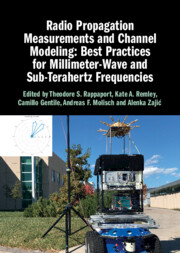Book contents
- Frontmatter
- Dedication
- Contents
- Contributors
- Preface
- 1 Introduction
- 2 Estimating Channel Characteristics from Measurements
- 3 Channel Sounders
- 4 Verification Techniques
- 5 Introduction to Millimeter-Wave Channel Modeling
- 6 Path Loss/Shadowing
- 7 Multipath Component Clustering
- 8 Dispersion Characteristics
- 9 Peer-to-Peer Networking
- 10 Temporal Variance: Literature Review on Human Blockage Models
- 11 Terahertz Channels
- 12 Connection between the Measurements and Models
- 13 Conclusions
- Index
11 - Terahertz Channels
Published online by Cambridge University Press: 18 August 2022
- Frontmatter
- Dedication
- Contents
- Contributors
- Preface
- 1 Introduction
- 2 Estimating Channel Characteristics from Measurements
- 3 Channel Sounders
- 4 Verification Techniques
- 5 Introduction to Millimeter-Wave Channel Modeling
- 6 Path Loss/Shadowing
- 7 Multipath Component Clustering
- 8 Dispersion Characteristics
- 9 Peer-to-Peer Networking
- 10 Temporal Variance: Literature Review on Human Blockage Models
- 11 Terahertz Channels
- 12 Connection between the Measurements and Models
- 13 Conclusions
- Index
Summary
Frequencies from 100 GHz to 3 THz are promising bands for the next generation of wireless communication systems because of the wide swaths of unused and unexplored spectrum. Terahertz wireless communications have two key advantages that can be combined to achieve very high data rates. First, the usable frequency band around each frequency is much larger, so each channel can have a much higher data rate. This alone can increase data rates to several hundreds of Gbit/s, but spatial multiplexing is still needed to reach Tbit/s data rates. Fortunately, THz frequencies allow smaller antennas and antenna spacing, which provides for more communication channels within the same array aperture within a chip package. However, to unlock THz wireless communications potential, several challenges in channel measurements and modeling need to be addressed, including antenna design, diffraction, reflection, and scattering. This chapter covers what is known to date in this new area.
Keywords
Information
- Type
- Chapter
- Information
- Radio Propagation Measurements and Channel Modeling: Best Practices for Millimeter-Wave and Sub-Terahertz Frequencies , pp. 232 - 258Publisher: Cambridge University PressPrint publication year: 2022
